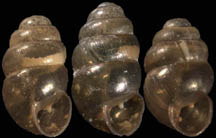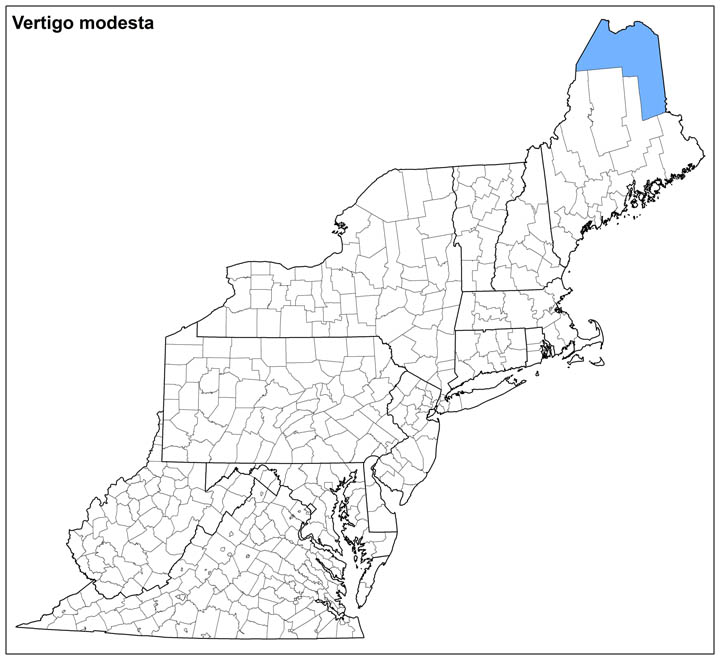Land Snails

Photo(s): From left to right: Vertigo modesta modesta, Yukon-Koyukuk Census Area, Alaska; Duplessis District, Quebec, Canada; Labrador, Canada. This species has not yet been found in the U.S. Northeast Region. Image © Jeffrey C. Nekola.
Click photo(s) to enlarge.
Vertigo (Boreovertigo) modesta modesta (Say, 1824) (not yet reported in Northeast Region)
Family: Vertiginidae
Identification
Height: 2.3-2.7 mm
Width: 1.2-1.5 mm
Whorls: 5
Vertigo modesta modesta is distinguished from other species in the subgenus Boreovertigo by its large (2.3–2.7 mm tall) shell with scattered, blunt and irregular striae, a blunt apertural crest, and (typically) 4-5 apertural lamellae. Vertigo m. modesta differs from V. modesta castanea of the western mountains by its more tapered apex and often stronger palatal lamellae, and from V. modesta concinnula of upland forests in the southwestern mountains by its scattered, blunt and irregular striae and shiny luster. While most V. modesta modesta populations have shells with two strong palatal lamellae, forms lacking one or both palatals have been seen in Labrador and Alberta (see image).
Taxonomy
All prior reports of V. modesta modesta from the New England states represent misidentified individuals of the large morph of Vertigo cristata (Nekola et al., in press). Vertigo modesta modesta differs from this species in its slightly larger shell and less distinct and more irregular striae. It is possible, however, that true V. m. modesta may be eventually located in willow-dominated wetlands at or above treeline in the Appalachians or Adirondacks.
Ecology
Vertigo modesta modesta is most commonly encountered in tundra or taiga wetlands and seeps, where it reaches its greatest populations in areas supporting dense willow growth (Nekola and Coles, 2010). Along its southern range limit, however, it may also be found in areas of cold air seepage along the lower fringe of large talus slopes (such as the type location along the Lake Superior shore), as well as on cold turf of seashore limestone pavements. The most southerly known population in eastern North America is found adjacent to cold air vents issuing from limestone fissures at Metcalf Rock along the Niagara Escarpment in southern Ontario. Type Locality Northwest Territory [of the U.S.A.], “somewhere near or west of the western end of Lake Superior”.
Distribution
This species ranges across the North American taiga and tundra from Newfoundland, Labrador, and Baffin Island west to interior Alaska. In the East, it extends south to southern Quebec, southern Ontario, northern Michigan, and northeastern Minnesota.
Conservation
NatureServe Global Rank: G5, Secure.
Jeff Nekola 9/2017
Range Map (click to enlarge)



